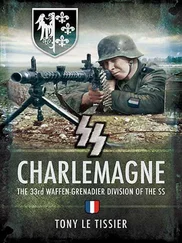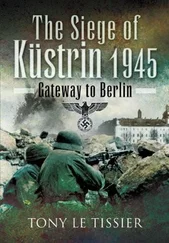General Busse’s Spreewald concentration now became a focus of round the clock attention for Air Chief Marshal A.A. Novikov, who devoted a large part of the resources of his 2nd, 16th and 18th Air Armies to the harassment of the 9th Army pocket, with as many as 60 to 100 aircraft in action at a time. [7] Novikov, ‘The Air Forces in the Berlin Operation’, p. 95; Wagner, Der 9. Fallschirmjägerdivision , pp. 355–6.
With 9th Army were tens of thousands of refugees from Germany’s eastern provinces who had been camping out in the woods since their arrival in the area during the winter. The Nazi Party authorities had been reluctant to initiate evacuation for fear of being accused of defeatism, with the consequence that civilians continued to remain in the combat area until the Soviet onslaught caught them out, as General Busse himself complained. [8] Busse, ‘Die letzte Schlacht der 9. Armee’, p. 157.
However, fear of the Soviet invaders led to evacuation on a vast scale where no stable front existed, as in the preceding winter when the Soviet forces had swept across from the Vistula to the Oder. Many of the refugees seeking shelter in the Spreewald came from the part of Germany east of the Oder, including the Warthegau province, part of which had been seized from Poland in 1939 and re-settled with ethnic Germans from the Baltic states, other parts of Poland, Bessarabia and Romania. [9] Noakes & Pridham, Nazism 1939–1945 , pp. 935–6.
Organising themselves in community-related treks, these refugees took what they could of their worldly possessions in horse-drawn wagons, or pulled them along in the four-wheeled type of handcart then common to German households for conveying heavy loads. The refugees were mainly women, children and the elderly, all able men of military age having long since been taken into the armed forces, and all others up to the age of 60 having more recently been conscripted into the Volkssturm.
In February 1945 the Nazi Party authorities had established a system for passing these refugees on, allowing them to stay overnight in the villages on their route but having them move on by 1000 hours the next day, only those who had fallen ill being allowed to remain. Halbe itself was accommodating about 1,000 refugees per night. [10] Führling, Endkampf an der Oderfront , p. 105.
It seems that a large number of those who had no relatives to head for, or who had chosen not to leave their fate to the authorities, had decided to camp out in the comparative safety of the Spreewald.
With the collapse of the 9th Army front, the number of existing refugees was greatly augmented by those fleeing their homes from the Fürstenwalde–Frankfurt–Cottbus area as the troops withdrew. Although there was sufficient food for everyone, internal communications rapidly deteriorated, and troops and civilians became hopelessly mixed in their predicament as the perimeter of the pocket contracted. Ammunition and fuel were in particularly short supply and when the artillery began running out of shells on 21 April, Colonel-General Heinrici at Army Group Weichsel advised General Busse to find some means of disengaging from the Soviet forces and to forget Hitler’s orders about holding on to the Oder. [11] Thorwald, Das Ende an der Elbe , pp. 88–9.
Consequently, General Busse started making preparations for a break-out as suggested by Heinrici. The redisposition of the newly acquired V Corps was part of his plan. As soon as the Frankfurt garrison could withdraw into his lines, V Corps and V SS Mountain Corps were to start a simultaneous withdrawal from their Oder/Neisse positions in two bounds, going back on either side of Friedland to the line Staupitz–Beeskow–junction of the Spree and the Oder–Spree Canal. [12] Lakowski/Stich, Der Kessel von Halbe 1945 , p. 42 [citing Federal Military Archives 19 XV/10, Sheet 71f].
The imminent danger to his northern flank caused Busse to decide to use Colonel-General Helmuth Weidling’s LVI Panzer Corps with the SS Panzergrenadier Divisions Nordland and Nederland to establish a screen along the line of the Spree west of Fürstenwalde, behind which those of his formations still on the Oder could withdraw westwards, but he was unable to bring himself to issue the necessary orders as this would have been in defiance of Hitler. [13] Ibid ., pp. 39–40.
He thus remained dependent upon the thinly spread 32nd SS Volunteer Grenadier Division’s battlegroup deployed south of the Spree to cover his north-west flank.
Part of Lieutenant-General Werner Marcks’ scattered 21st Panzer Division arrived opportunely in the Halbe area, and was sent to establish a new line of defence along the chain of lakes between Teupitz and Königs Wusterhausen facing west. As the men drove north through the Spreewald, they caught glimpses of the Soviet forces moving parallel to them on the autobahn. Marcks only had with him what remained of the 1st, 5th and Workshop Companies of the 22nd Panzer Regiment, Major Brand’s 21st Armoured Reconnaissance Battalion, the two battalions of the 125th Panzergrenadier Regiment and the 1st Company of the 192nd Panzergrenadiers, elements of the 220th Armoured Engineer Battalion, the staff and two battalions of the 155th Armoured Artillery Regiment Tannenberger , and the 305th Army Flak Battalion. [14] Kortenhaus, Der Einsatz der 21. Panzer-Division , pp. 133–4.
The remains of the 10th SS Armoured Reconnaissance Battalion Frundsberg , which was following these elements of 21st Panzer Division, then took up north-facing defensive positions just outside Königs. [15] Tieke, Das Ende zwischen Oder und Elbe , p. 173.
Ernst-Christian Gädtke, then serving with the 32nd SS Tank-Hunting Battalion in Riessen, near Fürstenberg, gives us some idea of the atmosphere in the ranks as 9th Army’s withdrawal began:
At 0500 hours we were alerted and ordered to prepare to move off. As we packed up the rumours started flying around. The Russians were said to be before Berlin.
At roll-call we were given no explanations as usual, only confirmation that the Russians were before Berlin and that we were to defend it. We left at 0530 hours for Fürstenwalde and Rauen.
In the damp, foggy, early spring morning, our tank-hunting company with its four assault guns rattled off to the west, complete with the supply section.
After the highly-charged garrulousness of the previous day, a grim silence now reigned. The speech had been knocked out of us, and the silence was quite profound. No one dared say what he was thinking or feared, as everyone now accepted the terrible truth that defeat was inevitable. Nevertheless, the step in thinking from foreboding to certainty was one that I did not take. I continued to do what I had been doing for so long now, as did so many others; I just suppressed what I didn’t want to accept.
So our journey to the west was somewhat despairing, grim and silent. The morning was foggy and became cloudy, remaining like that all day. The engines thundered monotonously, the tracks rattled, squeaking and screaming whenever we took a bend. We crouched down dumb and grim-faced in our hatches. The gun was overloaded and packed with infantry, who crouched under their tent-halves and clung on as usual. Everything was grey. We drove through villages and small market towns – there, too, everything was dull and grey. People stood on the streets in Müllrose, watching us pass with doubt and uncertainty. Could we have dispelled their anxieties and fears as we passed through, or were we no longer any use as defenders of the fatherland? We should have looked back at them full of confidence, but we couldn’t.
By afternoon we were in Rauen. The Russians were said to be already in Fürtstenwalde, north of the Spree. [16] Gädtke, Von der Oder zur Elbe , pp. 26–7.
Читать дальше












